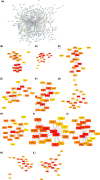Identification of metastasis and prognosis-associated genes for serous ovarian cancer
- PMID: 32510146
- PMCID: PMC7317593
- DOI: 10.1042/BSR20194324
Identification of metastasis and prognosis-associated genes for serous ovarian cancer
Abstract
Serous ovarian cancer is one of the most fatal gynecological tumors with an extremely low 5-year survival rate. Most patients are diagnosed at an advanced stage with wide metastasis. The dysregulation of genes serves an important role in the metastasis progression of ovarian cancer. Differentially expressed genes (DEGs) between primary tumors and metastases of serous ovarian cancer were screened out in the gene expression profile of GSE73168 from Gene Expression Omnibus (GEO). Cytoscape plugin cytoHubba and weighted gene co-expression network analysis (WGCNA) were utilized to select hub genes. Univariate and multivariate Cox regression analyses were used to screen out prognosis-associated genes. Furthermore, the Oncomine validation, prognostic analysis, methylation mechanism, gene set enrichment analysis (GSEA), TIMER database analysis and administration of candidate molecular drugs were conducted for hub genes. Nine hundred and fifty-seven DEGs were identified in the gene expression profile of GSE73168. After using Cytoscape plugin cytoHubba, 83 genes were verified. In co-expression network, the blue module was most closely related to tumor metastasis. Furthermore, the genes in Cytoscape were analyzed, showing that the blue module and screened 17 genes were closely associated with tumor metastasis. Univariate and multivariate Cox regression revealed that the age, stage and STMN2 were independent prognostic factors. The Cancer Genome Atlas (TCGA) suggested that the up-regulated expression of STMN2 was related to poor prognosis of ovarian cancer. Thus, STMN2 was considered as a new key gene after expression validation, survival analysis and TIMER database validation. GSEA confirmed that STMN2 was probably involved in ECM receptor interaction, focal adhesion, TGF beta signaling pathway and MAPK signaling pathway. Furthermore, three candidate small molecule drugs for tumor metastasis (diprophylline, valinomycin and anisomycin) were screened out. The quantitative reverse transcription-polymerase chain reaction (qRT-PCR) and western blot showed that STMN2 was highly expressed in ovarian cancer tissue and ovarian cancer cell lines. Further studies are needed to investigate these prognosis-associated genes for new therapy target.
Keywords: TIMER database analysis; bioinformatics analysis; prognosis; serous ovarian cancer; tumor metastasis; weighted gene coexpression network analysis (WGCNA).
© 2020 The Author(s).
Conflict of interest statement
The authors declare that there are no competing interests associated with the manuscript.
Figures







References
Publication types
MeSH terms
Substances
LinkOut - more resources
Full Text Sources
Other Literature Sources
Medical

